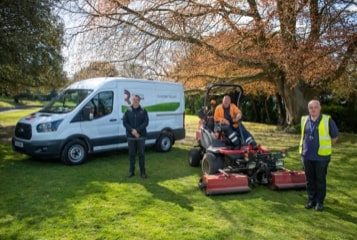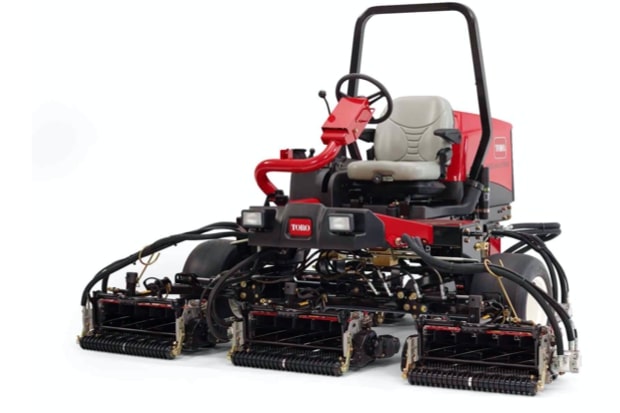- CONTACT US
- MOWERS
- VEHICLES
- APPLICATION
- Golf
- AERATORS
- VEHICLES

NEWS FOR COUNCILS, CONTRACTORS AND LANDSCAPERS
NEWS FOR COUNCILS,
CONTRACTORS AND LANDSCAPERS

IN THIS ISSUE
ALL STORIES

Framing
‘wild’ verges
Share this story: Twitter | Facebook | LinkedIn
MAINTENANCE OF THE COUNTRY’S GREEN SPACES HAS BEEN CHANGING SUBTLY FOR YEARS BUT REDUCED TEAMS DUE TO THE COVID-19 PANDEMIC HAS PUSHED THIS INTO A NATIONWIDE CONVERSATION AND PUT THE UK FIRMLY ON A PATH TO MANAGING THE COUNTRY’S GREEN SPACES IN A DIFFERENT WAY.
HERE, REESINK'S ALASTAIR ROWELL LOOKS AT THE EFFECT THIS HAS HAD ON THE WAY GREEN SPACES ARE MAINTAINED AND THE MACHINERY USED.

Alastair Rowell
UK sales manager, turfcare equipment, Reesink Turfcare
What is framing verges?
Cutting narrow strips around the wilder verges to frame them is a simple but effective way to give the perception of tidiness and help combat the view that wildflower-rich verges are untidy and neglected.
The Local Government Association says councils must keep verges short to ensure motorists have a good line of sight and allow pedestrians to walk safely alongside busy roads. Other reasons are to prevent the spread of weeds and invasive species into private gardens and pressure from local communities to maintain a certain aesthetic appearance.
Cutting narrow strips around the wilder verges to frame them is a simple but effective way to give the perception of tidiness and help combat the view that wildflower-rich verges are untidy and neglected, potentially offsetting negative feedback.

Maintenance of framing verges
Framing verges requires regular maintenance of between two to four weeks. Traditionally, councils, local authorities and contractors would use triple cylinder mowers or rotary mowers for keeping the grass shorter as they provide the best cut and after-cut appearance, but as they can only cope with grass that is cut quite frequently, they’re not suitable to this new approach.
This change in requirements makes the job of the mower three or four times as hard because they’re not cutting as regularly. The upshot is a flail mower - the better option for these areas because they can cope with longer grass, less frequent cuts and are cheaper to maintain.
A triple flail mower such as the Toro LT-F3000 mimics the size, cutting width and manoeuvrability of a traditional triple cylinder mower. The flail cutting heads are able to cut long and short grass, wet or dry, and leave a much better after-cut appearance than a rotary mower.

Customers can be a little nervous of investing in the unknown such as a flail instead of a traditional cylinder or rotary mower, which goes against a purchasing decision they’ve been making for years. But the technology around today and tough field testing mean perceptions are starting to change and councils, local authorities and contractors are seeing this as a viable solution for solving a lot of the mowing issues these budget constraints and less frequent mowing cycles create.
The Toro LT-F3000 has the added benefit of an interchangeable cylinder attachment which gives versatility and the capability for the front-facing triple mower to cut two ways if and when needed: tougher cutting with the flail or finer with the cylinder. Very useful for those maintaining roadside verges as well as local parks or playing fields.
Toro understands that the groundscare sector has many different areas and challenging environments to cut, from the widest open spaces to the narrowest verges, and roadsides with longer grass to recreational fields with shorter. Having a mower that can, with the easy attachment of a cylinder unit, tackle the longer grass and then multi-task by extending its use to leaving a premium finish on playing fields and sports grounds is a really cost-effective solution.
Plus, the LT-F3000 can also easily turn its hand to annual roadside verge grass cutting programmes, ensuring all visibility areas, sight lines and junctions are tackled as well as the bank and cutting to clear long grass and maximise control of vegetation height.
Framing wild verges is a cost-effective, practical solution in the journey to road verges being designed and managed to support an array of wildlife - just don’t forget to communicate any changes to verge management. Flower-rich verges are increasingly popular with local communities and are a great way of encouraging wildlife into the heart of the built environment and verge signage, like framing verges, makes clear that wilder verges are intentional and can engage local communities, helping to address negative perceptions of wilder verges.

FEATURED STORIES

Gold standard for the White Cliffs
Dover District Council opts for ReeAssurance from Reesink when it comes to fleet maintenance, going for gold cover for the ultimate peace of mind.
Dover District Council has benefitted from Reesink Turfcare's ReeAssure Gold Plan, which essentially acts as a five-year service plan/warranty, for four years.
READ FULL STORY >
New renewal agreement for Radley
It's been 10 years and counting for Radley College in Oxfordshire relying on Toro’s fine- turf and groundscare mowers to keep the school’s 228 acres in pristine condition.
World-class sporting facilities are one of the cornerstones of the prestigious boys’ school, so it goes without saying that maintaining impeccable grounds is a must.
READ FULL STORY >
Unrivalled lightness for sports mowing
Toro’s Reelmaster 3575-D is the lightest available cylinder mower in its class, bringing an unrivalled lightness of cut to pitches, training grounds and academies.
Designed to be 20 percent lighter than traditional larger cylinder mowers, Toro’s Reelmaster 3575-D weighs just 2550lbs including the cutting units.
READ FULL STORY >Reesink UK LTD | 1-3 Station Road, St Neots PE19 1QF | Registered in England
Reesink UK LTD is authorised and regulated by the Financial Conduct Authority.













